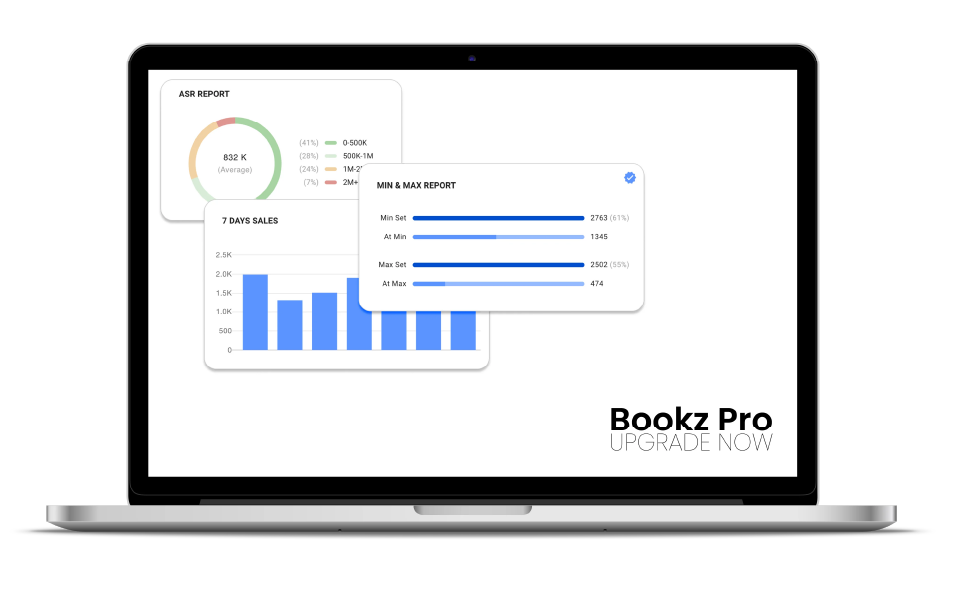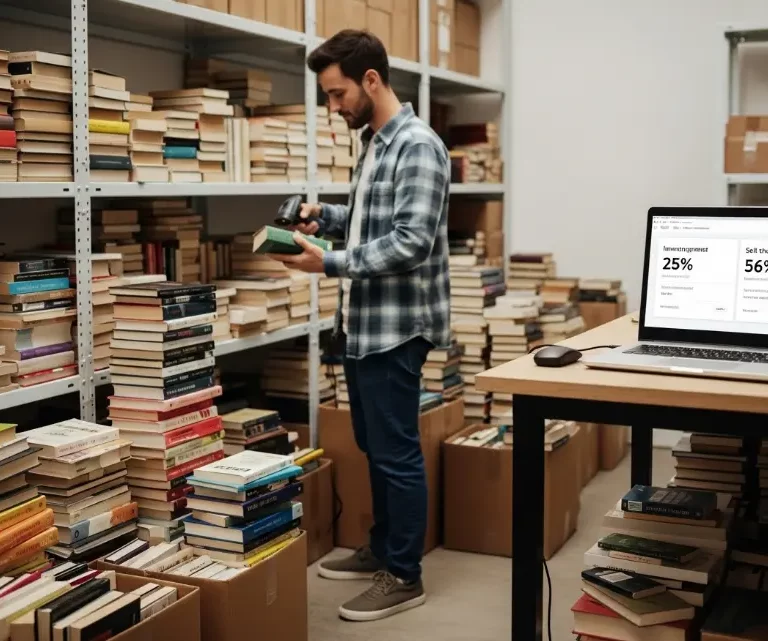What Are Counterfeit Books? Here Are Important Tips To Avoid It

Introduction
Fake books? Seriously? It’s a bigger problem than you might think! Not only is it unfair to authors and publishers, but it’s also a real headache for sellers, especially those on Amazon. Imagine finding out you’ve been selling fake books – yikes!
Selling fake stuff can get you in big trouble with Amazon. You could lose money, get your account suspended, or, even worse, damage your reputation. It’s a scary thought! We know you want to avoid this mess, so we’re here to help.
Let’s break down what makes a book fake, why it’s a problem, how to spot one a mile away and how to monetize suspected gated books and have peace of mind. So, continue reading this blog through the end.
What Is A Counterfeit Book?
Counterfeit books are fake copies of original works made without permission from the authors or publishers. They are designed to trick people into thinking they are buying real books. These counterfeit versions can vary in quality; some are poorly printed with blurry text and images, while others look very similar to the originals and can be hard to tell apart at first. Because they are made without authorization, counterfeit books are illegal and unethical.
These fake books usually look a little off – maybe the words are crooked, the paper is thin, or there’s no copyright info. It’s tricky to spot them, but it’s important to know what to look for. Counterfeit books can be tricky to spot because they’re often made to look as real as possible. That’s why it’s important to know how to tell a real book from a fake one. We’ll talk about that in a bit!
How Do You Identify Counterfeit Books?
One of the significant challenges Amazon booksellers face is the risk of unintentionally selling counterfeit textbooks. This concern is heightened by stories of sellers caught in sting operations by publishers, leading to severe repercussions when reported to Amazon.
The consequences can range from minor penalties, such as a temporary loss of the Buy Box, to more severe outcomes, like account suspension. Although some may argue that the fear of counterfeit textbooks is exaggerated within the Amazon-selling community, it remains essential to be vigilant and informed about the signs of counterfeit books.
There are several key indicators to watch for when identifying counterfeit textbooks.
1. Suspiciously Low Prices
One of the most telling signs of a counterfeit book is when a high-demand textbook is being sold at a significantly lower price than usual. This is particularly common in online marketplaces where counterfeiters aim to quickly sell large quantities of fake books, or when buying from untrustworthy vendors, discount book websites, or unfamiliar international sellers. If you see a new, high-demand textbook listed at a bargain price, especially from these sources, it’s likely a counterfeit.
2. Poor Quality Cover Art
Authentic textbooks from reputable publishers typically have high-quality cover designs. If the cover art is blurry, pixelated, or lacks the vibrant colors expected from a legitimate textbook, it’s a major red flag.
3. Distorted Barcodes
The barcode is another critical element to inspect. Genuine textbooks will have clear, sharp barcodes, while counterfeit versions often feature blurry or distorted barcodes. If the barcode appears fuzzy, it strongly indicates that the book is not authentic.
4. Inferior Paper Quality
High-quality textbooks are printed on thick, glossy paper. If the pages are thin, flimsy, or allow light to pass through, it’s a strong sign of a counterfeit.
5. Inaccurate Dimensions
Compare the textbook’s physical dimensions with the specifications listed on Amazon. If the book is narrower or thinner than reported, it could be a counterfeit.
In addition to these primary indicators, other signs may also suggest a book is counterfeit. These include off-center printing, low-quality binding, and the absence of a copyright symbol.
Understanding these warning signs is crucial for sellers to protect their accounts and maintain the integrity of their business. By being aware of what to look for, sellers can significantly reduce the risk of dealing with counterfeit textbooks, ensuring they provide authentic products to their customers.
Most Counterfeited Books To Look Out For
Textbooks are prime targets for counterfeiters due to their high price tags and strong demand. This is especially true for books on the EPEG (Educational Publishers Enforcement Group) watchlist – books that are frequently counterfeited. While this list isn’t publicly shared, Amazon often restricts or gates sellers from listing these high-risk titles. When you find copies of these textbooks, examine them closely for signs of counterfeiting.
1. Textbooks for STEM Subjects
Engineering Textbooks: Due to their technical nature and often high prices, engineering textbooks are prime targets for counterfeiters. Titles in fields like electrical engineering, mechanical engineering, and civil engineering are particularly vulnerable.
Science Textbooks: Textbooks for biology, chemistry, and physics often contain complex diagrams, images, and equations, making them challenging to replicate accurately. This complexity, combined with the high demand for these books, makes them attractive to counterfeiters.
2. Business and Economics Textbooks
Business Administration Textbooks: Books on topics like marketing, finance, and management are popular among students and professionals, making them targets for counterfeiters.
Economics Textbooks: Given the subject matter’s complexity and the frequent release of new editions, economics textbooks are susceptible to counterfeiting.
3. Healthcare and Medical Textbooks
Nursing Textbooks: The healthcare industry is a profitable market, and nursing textbooks, in particular, are often counterfeited. Accurate information is crucial in this field, making counterfeit books a serious concern.
Medical Textbooks: Due to their high cost and the importance of accurate information, medical textbooks are also targets for counterfeiters.
4. Law and Criminal Justice Textbooks
Law Textbooks: Given the legal implications of accurate information, law textbooks are a prime target for counterfeiters. The complexity of legal concepts and the high cost of these books contribute to the problem.
Criminal Justice Textbooks: As with law textbooks, the importance of accurate information in criminal justice makes these books vulnerable to counterfeiting. It’s crucial to remember that this list is not exhaustive. Counterfeiters are opportunistic and may target textbooks from other disciplines as well. Additionally, the prevalence of counterfeits can vary by region and over time.
All in One Software
for Book Sellers
Scout Better – List Faster – Reprice Smarter
Over 30% Business Growth
Achieved by Our Clients

Tips To Avoid Counterfeit Books
Explore the essential tips to help you identify and avoid counterfeit books, ensuring that you make informed purchasing decisions and protect yourself from potential losses.
1. Inspect the Book Closely
- Check the book cover: Is it high-quality, and does it match the publisher’s design? Counterfeit covers often have low-grade printing, off-colors, and sloppy alignment.
- Examine the pages: Are they printed on thin, cheap paper? Counterfeit books often use plain, unevenly cut pages instead of the glossy paper used in originals.
- Look for printing issues: Blurry text, overlapping pages, missing pages, low-quality images, and misprints are signs of counterfeiting.
- Measure the dimensions: Counterfeiters often make the book narrower to use less paper, so compare the size to the publisher’s specs.
- Check the ISBN using Bookz Pro: If the book information matches but the appearance is very different, it’s likely counterfeit. Use ISBNdb to verify quickly.
2. Research the Seller
- Buy directly from the publisher, authorized retailers, or trusted used booksellers.
- Avoid unknown sellers, especially those without contact info, address, or company details.
- Look for seller reviews mentioning counterfeit or poor-quality books.
3. Spot Other Red Flags
- Unusually low prices are a red flag for counterfeits.
- Inconsistent book quality, like blurry images or missing pages, is a warning sign.
- Mismatched ISBNs on the book, cover, and packaging are a clear indication of a counterfeit.
Purchasing counterfeit books supports illegal activity and can even lead to legal trouble for the buyer. By carefully inspecting books and buying from reputable sellers, you can avoid falling victim to this growing problem. If you suspect you received a counterfeit, report it to the publisher and return the book.
Send Your Counterfeit Textbooks To Restricted Inventory
Make Money On Restricted Items Now!
We will sell your restricted Amazon items for you on a 50:50 split of net profits, never making our cut higher than $20. All you have to do is send the items to us and we’ll take care of the rest!
Over 3000 Satisfied Clients
Thanks to Our Ungated Accounts
Every Amazon seller experiences frustration when having or purchasing counterfeit books. That is why we created solutions to address this challenge. Bookz Pro offers an all-in-one service to reprice, list, and scout books. If Bookz Pro flags your book as restricted, go to Restricted Inventory so that it will be managed well. Restricted Inventory aims to help sellers identify their restricted items and make them profitable.
Pair your bookselling tools accordingly to streamline processes, Bookz Pro and Restricted Inventory can be your effortless go-to software to avoid the pitfalls of counterfeit books.
To learn how to be on top of the bookselling industry, you can get this exclusive free Amazon Book Reselling Blueprint to guide you with the tips and tricks and never-been-discussed strategies to increase ROI!
Conclusion
Booksellers must recognize counterfeit books and know how to identify them. By understanding common signs of counterfeits, such as low-quality printing and suspiciously low prices, they can protect their businesses from potential losses and ensure they are selling authentic products. Implementing these strategies and using efficient tools not only secures their investments but also helps uphold the integrity of the publishing industry.
Frequently Asked Questions
Look for signs such as poor-quality cover art, distorted barcodes, thin or flimsy paper, suspiciously low prices, and inaccurate dimensions compared to the publisher’s specifications.
Counterfeiting can occur across various industries, but in the context of books, it primarily involves the unauthorized reproduction of original works. Examples include fake textbooks that imitate the appearance of legitimate editions but are printed on inferior paper, have blurry cover art, or lack proper copyright information. Other instances of counterfeiting can include imitation luxury goods, such as designer handbags and watches, where counterfeit items are made to look like the originals but are of significantly lower quality.
To determine if a book is an original, check for high-quality cover art, clear barcodes, thick paper, and accurate dimensions compared to the publisher’s specifications. Look for a copyright symbol and inspect the overall print quality for any signs of poor production.
If you suspect a book is counterfeit, inspect it carefully for signs of forgery, report it to the publisher, and return it to the seller for a refund. Keeping records of your purchase can also help in resolving any disputes.
Yes, you can verify a book’s authenticity by checking its ISBN against online databases, ensuring that the book’s details match those provided by the publisher. Additionally, examining the physical characteristics of the book can help identify any discrepancies.



